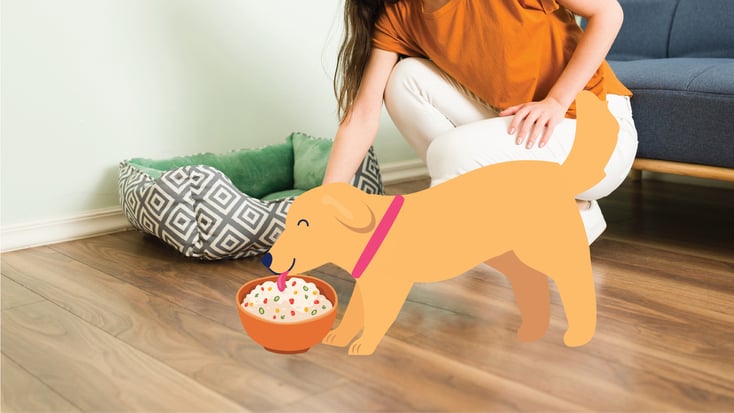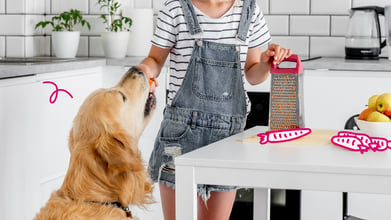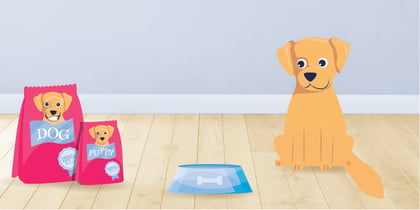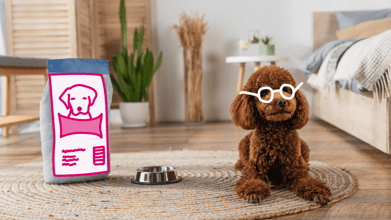Homemade Food for Dogs

Homemade dog food has become increasingly popular in the last few years, as many owners are taking an increasing interest in what their dogs eat. However, making homemade dog food is not as easy as we might like, and there can be serious risks if we get it wrong.
If you are wondering how to make homemade dog food – and how much homemade dog food to feed your dog safely – then read on!
Benefits of Homemade Dog Food
Making food for your dog at home can be a very enjoyable experience for both our dogs and ourselves. It can give you a chance to feed them something a little different, and perhaps a little bit more interesting than their day-to-day food. If your dog is a fussy eater, freshly cooked food can be more interesting than pre-prepared food, too.
Some people claim that homemade food is better for dogs’ health, but there isn’t enough scientific evidence to back up that claim at the moment.
Risks of Homemade Dog Food
Dogs need a particular balance of nutrients in their diet in order to stay healthy. There are thirty-seven individual essential nutrients that dogs require, and too little (or too much) can lead to serious health problems.
Making a complete and balanced diet for your dog at home can be very difficult. There are many homemade dog food recipes available online or in books, but studies have shown that almost all of these are unbalanced – even those that are written by veterinarians.
Some dogs may be keener to eat home-prepared food than pre-prepared food. This can be useful for picky eaters but can create the risk of dogs over-eating and becoming overweight or obese.
How To Feed Homemade Dog Food Safely
There are a few different ways to safely feed your dog food that you have prepared at home.
The Ten Percent Rule
If you are wondering how much homemade dog food to feed, but don’t want to risk your dog’s diet becoming unbalanced, then the safest way to do this is to have ninety percent of your dog’s food as a complete and balanced diet, and then ten percent as home-cooked food.
The complete and balanced portion can be kibble, canned food, or any other diet that has been formulated according to AAFCO nutritional guidelines. The home-cooked food can contain any foods that are safe for dogs to eat – see later for some suggestions! Be sure to weigh out your dog’s food carefully to make sure the home-cooked food is no more than ten percent of the overall amount each day.
Fresh-Cooked Commercial Foods
If your dog prefers to eat home-style food, some companies make fresh-cooked diets that you can reheat at home which are complete and balanced and follow AAFCO guidelines.
Board-Certified Veterinary Nutritionist
If you want to feed your dog fully home-cooked food, then the safest way to do this is to consult with a specialist in veterinary nutrition. Regular veterinarians are not qualified to formulate dog diets, so look for one who is a member of the American College of Veterinary Nutritionists (ACVN) or the European College of Veterinary and Comparative Nutrition (ECVCN). They can formulate a diet that is tailored to your dog’s needs.
Raw Meat
Raw meat carries the danger of serious food poisoning for both dogs and humans, and there is no clear benefit for dogs’ overall health when compared to cooked meat. If you want to include some raw meat in your dog’s diet, it may be safer to choose a brand that has been frozen or freeze-dried to reduce the number of bacteria growing on the meat. Be sure to keep your dog’s food and dishes separate from where you prepare human food and follow strict hygiene measures to prevent it from contaminating your crockery.
Homemade Dog Food Recipes
If you are wanting to make a topper to add to your dog’s food, then you should choose ingredients that are safe for your dog to eat. These include:
Meats
-
De-boned muscle meat, such as chicken, lamb, beef, or salmon.
-
Minced meat
-
Organ meat such as kidney, liver, or tripe - as an occasional treat. These are high in fat, and in certain vitamins that can be toxic in large amounts.
Any meat should be cooked for both your dog’s safety and yours.
Vegetables
Most vegetables are safe for dogs to eat. You can offer them cooked or raw, and some dogs will prefer one or the other. Good choices include:
-
Carrots
-
Sweet Potato
-
Green Beans
-
Peas
-
Cucumber
If your dog eats quickly, make sure that the vegetables are sliced or diced into small pieces (the same size as a piece of kibble) to prevent them from choking.
Sauces
Many sauces, gravies, and stocks are high in salt, and can also contain high levels of onion or garlic, which can be poisonous to dogs. If you want to add some moisture to your dog’s food, you can either add some warm water and allow it to soak up the juices from the food, or use a little homemade stock with no added salt.
Remember to make sure that any added food is not more than ten percent of your dog’s overall diet, by weight.
Feeding your dog a diet entirely made up of homemade food can be challenging, and it is best to consult a board-certified veterinary specialist if you want to do this. However, adding some home-cooked food to your dog’s diet is usually safe to do as long as you pick the right ingredient, and the home-cooked food is no more than ten percent of the dog’s overall food portion, by weight. The rest of the diet should be a complete and balanced diet that is formulated according to AAFCO nutritional guidelines.
If you are unsure of the best way to feed your dog, or they have health issues that are linked to their diet, then you should speak to a veterinarian for more advice.
Frequently Asked Questions
Is homemade dog food better for dogs?
There is no strong evidence that eating a homemade diet is better for a healthy dog than a commercially prepared one. Some pet parents may prefer to feed it, and some dogs may prefer to eat it! However, there is rarely a medical reason for doing this.
How can I cook a complete and balanced diet for my dog at home?
Creating a truly balanced diet for a dog is challenging, and most online recipes are not sufficient for this. A board-certified veterinary nutritionist can help you create a properly balanced diet that is tailored to your dog’s needs.






